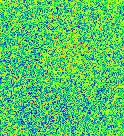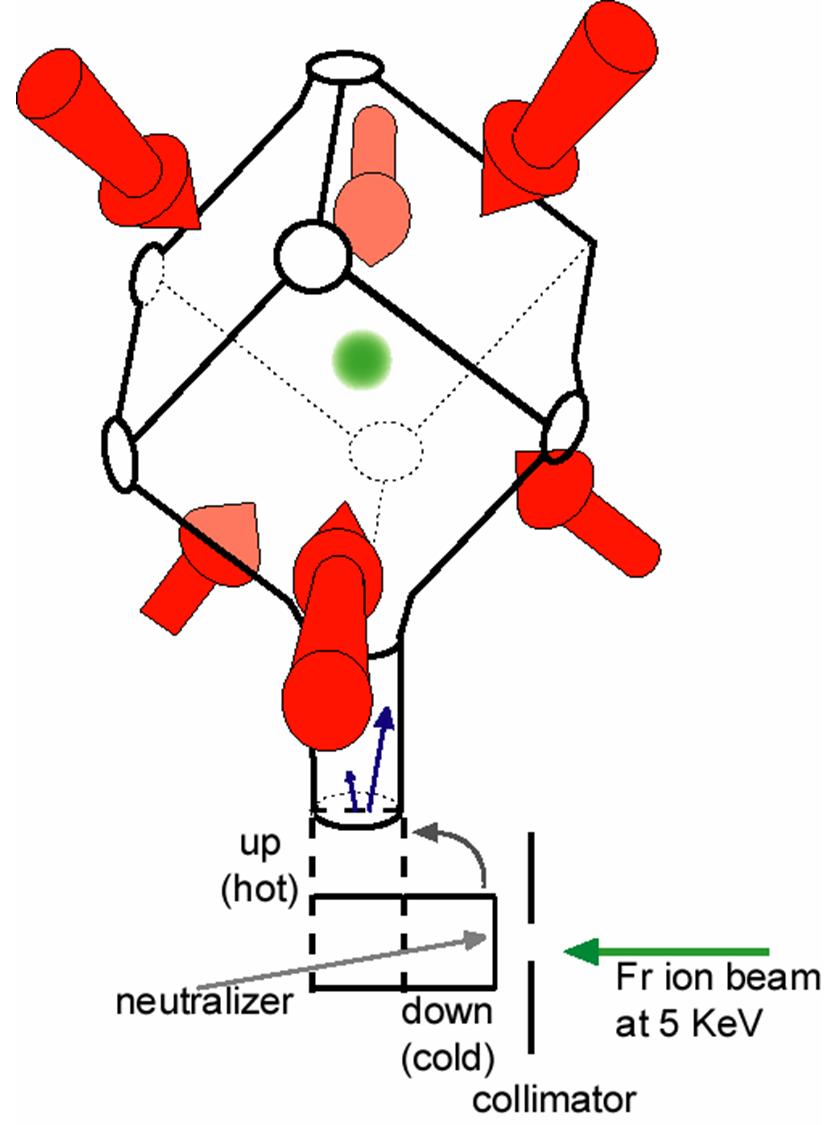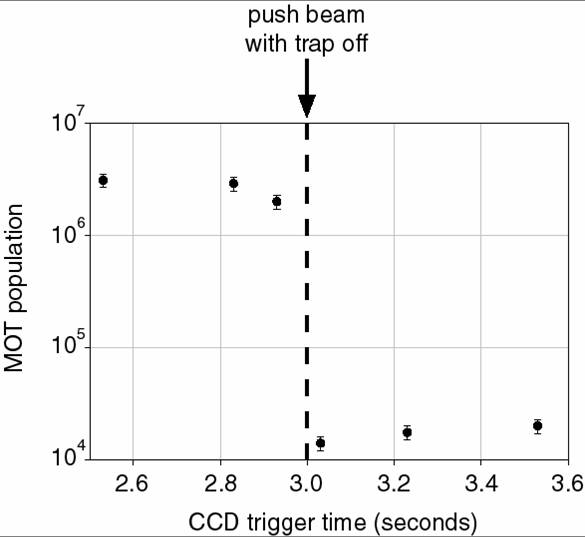|
High efficiency MOT for francium
|
|
The primary difficulty of working with francium is
its availability. We are only able to to deliver ~106 Fr/s
to the MOT apparatus. Since we need ~106 atoms for
a PNC measurement and the lifetime of francium is typically 3 minutes, we must
trap the francium as efficiently as possible.
We designed and built several prototypes of
apparatus for high efficiency trapping of francium. While most MOTs have a
trapping efficiency on the order of 0.01%, the final design that is presented
here successfully collects francium with a ~1.5% trapping efficiency.
The apparatus can maintain an average MOT population of 50,000 atoms,
and is capable of peak populations of over 200,000 atoms. In
the future, by transfering the collected francium to a "science" MOT in a 2nd
vacuum chamber with better a vacuum lifetime, we expect steady state MOT
populations of ~106 atoms.
|

Movie of a high efficiency 210Fr MOT.
|
|
We obtain a high efficiency by integrating the following three features into
our apparatus:
-
Large high power trapping beams:
We use large 3 cm (1/e intensity diameter) laser beams with
typical peak intensity of 18 mW/cm2. The large high
power beams guarantee a large capture velocity, since the stopping power (high
intensity) and stopping distance (large beams) are both large. The large beams
and intensity allow us to operate the MOT at a detuning of -4Γ
from the cycling transition, which further increases the capture velocity.
Significant laser intensity extends out to a diameter of 5 cm,
thus guaranteeing that the atoms inside the 5 cm × 5 cm × 5 cm
trapping cell will be inside the laser intersection volume most of the time.
|
-
Dry film coated cell:
We use a silane-based dry film coating (SC-77, Silar Laboratories), which has
the remarkable property that francium (and rubidium) atoms that land on its
surface, remain stuck to it for only a few microseconds during which they
rethermalize to room temperature. Untrapped atoms, with velocities above the
capture threshold of the MOT, are rethermalized and have another opportunity to
be trapped as they pass MOT when they escape the surface: atoms make multiple
passes through the MOT with a new rethermalized velocity on each pass, thus
increasing the total probability of being trapped.
-
Closed cell, pulsed MOT operation:
We operate the MOT on cycle: we collect francium ions on a neutralizer foil for
32 s, and then load the MOT by turning on the dispenser for 1 s and releasing
the atoms into the trapping cell. We use the neutralizer to plug the
entrance/exit port of the trapping cell during the two part cycle:
-
Collection phase: the neutralizer is in the
path of the ion beam, and the cell port is unblocked to maintain the ultra-high
vacuum of ~10-9
Torr in the trapping chamber.
-
Trapping phase: the neutralizer swings up to
the trapping cell port and blocks it while releasing the francium as neutral
atoms.
|

High efficiency francium MOT apparatus.
|
|
By blocking the exit port of the MOT cell, the number of atom
bounces will be maximized and depend only on the quality of the dry-film
coating and the neutralizer.
|
|
Trapping efficiency measurement
We measure the trapping efficiency of our MOT by
capturing atoms from the neutralizer, rapidly expulsing them with a push beam
(and the trap off), and then turning the MOT back on again. The ratio of the
MOT populations after and before the expulsion is the trapping efficiency. We
use rubidium for better signal-to-noise and measure a trapping efficiency
of ~1.8% with this technique (see figure on left for a plot of the
data).
We also measure the trapping efficiency by taking
the ratio of the ion beam current and and the loading rate of the MOT. With
francium, we measure a trapping efficiency of ~1.2%.
|

Trapping efficiency measurement data.
|
|
MOT temperature measurement
We determine the temperature of the trapped francium by turning of the MOT
laser beams and measuring the ballistic expansion of the cold atomic cloud by
fluorescence imaging (see sample data below and in the movie on the right).
With these data, we measure a temperature of 75 ľK.
|

|
|
For more information on the high efficiency MOT, please see:
S. Aubin, E. Gomez, L. A. Orozco, and G. D. Sprouse
High efficiency magneto-optical trap for unstable isotopes
Rev. Sci. Instrum. 74, 4342-4351 (2003)
[PDF]
|
|
|





